| As the grass is not growing yet, the cattle need to be fed. Each morning starts out heading behind the house and loading the pickup truck with twelve five gallon buckets of cattle feed, soy bean husk pellets in this case.
This is the view from behind the house in the morning (with the bare trees making interesting shadows. You can see the feed silo to the left of the picture. |
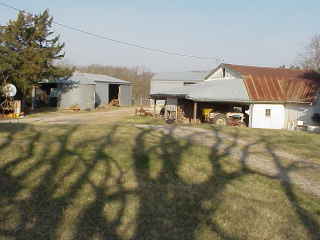 |
| The cattle really look forward to their feed as it is highly nutritious and they usually come to greet us at their feeding troughs. Here are the seven heifers that Martin held back
from the last set of calves he sold. I think it would be good if he kept them as cows to have calves as they are a good looking bunch. Here they are enjoying their feed (only two buckets at this stop). |
 |
| For the larger herds, giving them their feed is harder as they all try get as much as they can (and pushing and shoving is not unheard of). It is a team effort with Martin first lining up the tubs about five feet apart
and then Bev driving the truck as slowly as possible (just idling in the lowest gear) while Martin fills the tubs from the back of the truck.
Here is a five second video (120K, about 40 second download) of Martin filling the tubs and then one of Bev's view from the truck (that is NPR on the radio). |
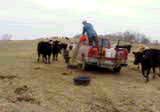

If your browser is not set up to show movies you will get an error dialog box instead of a player and can just press cancel. |
| Bev's job is challenging as she needs to insure she doesn't hit any of the cows or calves, blowing the horn as necessary, while staying close to the tubs. In the video above you can watch the little calf barely visible
in front of the truck on the left. Martin puts two thirds bucket into each tub (holding a third back and then combining the remainders)
as well as yelling at the cows as necessary to get them to move their heads out of the tubs so that he can get the feed in. Here is a herd of cows enjoying their feed. |
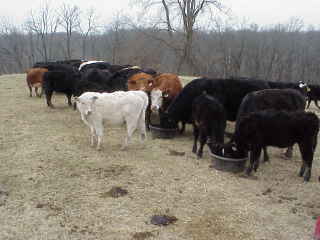 |
| Of course the feed is just a supplement for the soon to deliver or still lactating cows; the herd of summer calving cows does not get any feed. In any case, we also deliver five to seven bales of hay
to the cows each day. All the hay that Martin put up last year has been used, so now we are using purchased hay which is kept in the area across the road from the house. |
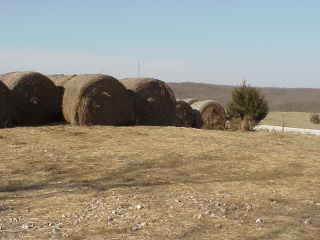 |
| Their pickup truck has two lifting rods which they use to impale the bale. Here is a five second video (120K, about 40 second download) of the pick up truck backing into the bale
and then starting to lift the bale. Martin moves the herds to different fields so that the cattle will 'fertilize' the fields evenly and the grass won't get too beaten down.
They also like to leave the hay on the sides of hill as that is where the extra nutrients are needed most (cattle mostly rest and chew their cud on either the ridge tops or under the trees if it is hot).
|
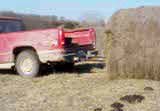
If your browser is not set up to show movies you will get an error dialog box instead of a player and can just press cancel. |
| So, instead of just leaving the bale out,
they roll it down the side of hill that needs the fertilizer. Here is a five second video (120K, about 40 second download) of a bale unwinding down the side of a needy hill; it starts just after it was bumped by the truck.
Of course there is excitement with each unwinding in wondering which direction the bale will take and whether it will roll into a ditch at the bottom of the hill. |

If your browser is not set up to show movies you will get an error dialog box instead of a player and can just press cancel. |
| They also need to insure that the cattle have water. One watering tub had the hose blocked by an acorn (presumably hidden there by an industrious squirrel), but until we discovered the problem,
the normal 300 gallon tub had been drunk dry by the herd because of the slow flow. We had left another field and tub accessable, but the cows had forgotten about the other water source. Martin called the cows (a
sort of 'Yee who!') and here the herd is coming to see what good thing he has for them. They were pretty thirsty it seems. |

If your browser is not set up to show movies you will get an error dialog box instead of a player and can just press cancel. |
| During the winter (and early spring), the morning is often spent feeding and looking after the cattle. That leaves the afternoon for chores. Here is a picture of Martin driving the smallest tractor (they have five of different
sizes and ages, this one is from the 50's). The tractor has a seeder on the back and is spreading clover seed. Behind that is a harrow (sort of a chain mat with iron hooks protruding) to break up the cow pies and such. I also spent
a few hours seeding and the ground is a lot steeper and bumpier than it looks from a distance.
Our Uncle Henry was killed about ten years ago when he was trying to mow a hill that was just too steep and bumpy and that tractor turned over on him. Needless to say we are very careful of steep and bumpy hills. |
 |
| Here is a picture of the harrow by itself. Sometimes I take out the harrow and a pitch fork with the smallest tractor (above) and use it to break up cow pies as well as spread the hay
around that the cattle didn't eat (if there were mostly thorns and thistle, for example. When the old hay is too deep, it will kill the grass. The harrow isn't very good at spreading the hay around when it is really deep.
Instead clumps roll out from under it. However, it use the harrow to move the clumps away from the main mass of hay so that it is easier to spread around thin enough to not kill the grass. |
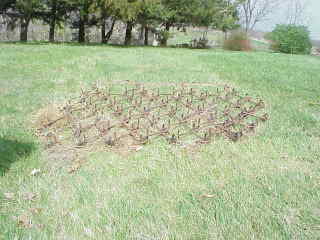 |
| Mowing is another chore in the spring and fall. Here is Martin driving one of the larger tractors (it has a front loader for moving bales of hay and such) and pulling the rotating blade mower. It takes longer to use that
mower as it is only six feet wide, but it can cut through saplings that are a couple of inches thick; so he uses it on really rough areas. The cattle will keep the grass short, but they won't eat the weeds, bushes, thorns, or saplings. That is
main reason for mowing pasture land. This side of the hill could have been cut with the side mounted alternating sicle mower which has a nine foot reach, but other parts of this field really needed rotating blade mower. |
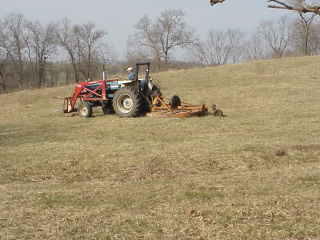 |
| When I was visiting Felix as a boy I remember the old white horse barn behind the house where they kept the horses we would ride. It was white as Felix never was one to go along with silly traditions
like painting a barn red. However, that barn burned down about 25 years ago and was replaced with the one shown here (from the other side). The white addition extends all the way around to the front and is the holding and sorting area
for when they need to weigh or vaccinate or whatever the cows individually. |
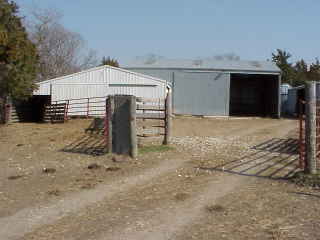 |
| The horse barn is in quite good shape for a 25 year old barn, but over the years four of the support beams had rotted out and two had been broken (tractors can push pretty hard). So I was able to
dig six holes for new beams to bolt to the old beams. Here you can see the first new beam before it was bolted into place (it was the worst and you can see the light shining through the remanants of the old beam. |
 |
| Here are the four replacement beams for the ones which had rotted out. Only the second from the right was still carrying weight else that end of the barn would have started sagging.
I was amazed when I was digging the post holes for the new beams to support the barn that I could dig down three feet
with just a post hole digger (two shovels in a sort of X) as I only encountered one hand size rock to impede my digging. |
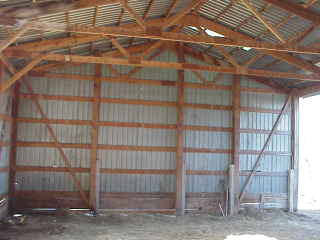 |
| One of the side beams that had been broken, broke all the way through and the wall started sagging. We used a jack and a board nailed on the outside wall to raise the wall and push it back in so that
the new beam would support the wall level and straight. Here you can see the result (the sag was only a couple of inches). You can also sort of make out the post hole digger and iron bar I used to dig the holes, etc.. |
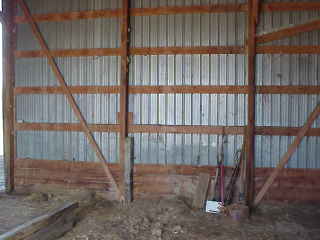 |
| Martin and Bev rent or own about a thousand acres of land which suggests that there are not a lot of people living in this part of Missouri right now.
When you are out doing your chores, when you turn off the truck or tractor, about the only sounds you will hear are the wind, the birds, and the cows. It is really pretty quiet.
Here is one of the prettier views from their front yard. |
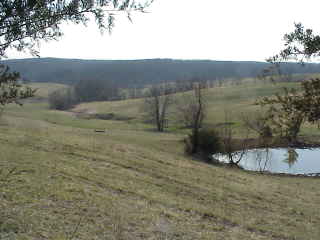 |